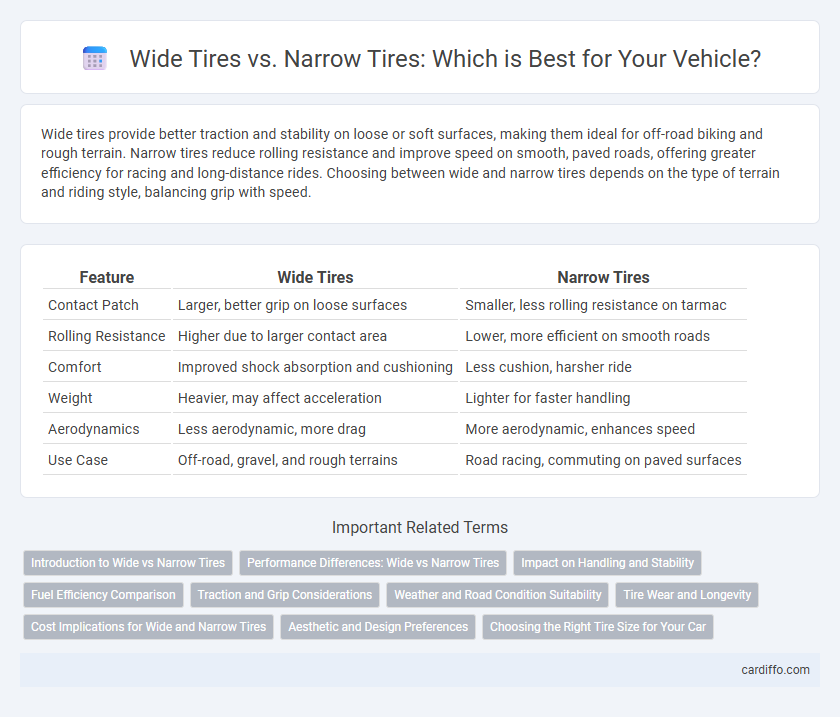Wide tires provide better traction and stability on loose or soft surfaces, making them ideal for off-road biking and rough terrain. Narrow tires reduce rolling resistance and improve speed on smooth, paved roads, offering greater efficiency for racing and long-distance rides. Choosing between wide and narrow tires depends on the type of terrain and riding style, balancing grip with speed.
Table of Comparison
| Feature | Wide Tires | Narrow Tires |
|---|---|---|
| Contact Patch | Larger, better grip on loose surfaces | Smaller, less rolling resistance on tarmac |
| Rolling Resistance | Higher due to larger contact area | Lower, more efficient on smooth roads |
| Comfort | Improved shock absorption and cushioning | Less cushion, harsher ride |
| Weight | Heavier, may affect acceleration | Lighter for faster handling |
| Aerodynamics | Less aerodynamic, more drag | More aerodynamic, enhances speed |
| Use Case | Off-road, gravel, and rough terrains | Road racing, commuting on paved surfaces |
Introduction to Wide vs Narrow Tires
Wide tires deliver enhanced grip and stability by increasing the contact patch with the road, making them ideal for high-performance and off-road vehicles. Narrow tires, by contrast, reduce rolling resistance and improve fuel efficiency, commonly favored in urban and long-distance driving. Choosing between wide and narrow tires depends on vehicle type, driving conditions, and desired performance characteristics.
Performance Differences: Wide vs Narrow Tires
Wide tires provide increased traction and stability due to a larger contact patch with the road surface, enhancing cornering grip and braking performance. Narrow tires typically offer reduced rolling resistance and better efficiency on smooth surfaces, making them advantageous for endurance and speed in certain conditions. However, wide tires can be heavier and less aerodynamic, potentially impacting acceleration and fuel economy compared to their narrow counterparts.
Impact on Handling and Stability
Wide tires provide increased contact patch with the road surface, enhancing grip and improving cornering stability, especially in dry conditions. Narrow tires generate less rolling resistance and cut through water more efficiently, offering better control and stability in wet or slippery environments. Both tire widths affect handling dynamics differently, with wide tires favoring high-speed stability and narrow tires optimizing maneuverability in varying road conditions.
Fuel Efficiency Comparison
Wide tires increase rolling resistance compared to narrow tires, which often leads to reduced fuel efficiency in vehicles. Narrow tires typically have less contact area with the road, minimizing friction and improving gas mileage by up to 3-5%. Vehicle manufacturers often recommend narrow tires for models prioritizing fuel economy due to their lower aerodynamic drag and lighter weight.
Traction and Grip Considerations
Wide tires offer increased traction by maximizing the contact patch with the road surface, enhancing grip during acceleration and cornering on dry conditions. Narrow tires concentrate the vehicle's weight on a smaller contact area, often improving performance on wet or slippery roads by cutting through water more effectively and reducing hydroplaning risk. Choosing between wide and narrow tires depends on driving conditions, with wide tires favoring dry traction and narrow tires providing superior grip in wet environments.
Weather and Road Condition Suitability
Wide tires excel in dry and snowy conditions by providing a larger contact patch for improved traction and stability on wet or slippery roads. Narrow tires perform better on icy and slushy surfaces, as the smaller footprint concentrates pressure to cut through snow and ice for enhanced grip. Selecting tire width depends on prevailing weather patterns and road conditions, optimizing safety and performance accordingly.
Tire Wear and Longevity
Wide tires generally exhibit increased tire wear due to a larger contact patch that promotes greater friction, especially under aggressive driving conditions. Narrow tires tend to wear more evenly and often last longer because the reduced surface area minimizes heat buildup and stress on the rubber compound. Proper tire maintenance, including regular rotation and correct inflation, is critical for maximizing the longevity of both wide and narrow tire designs.
Cost Implications for Wide and Narrow Tires
Wide tires typically have higher initial costs due to increased material use and manufacturing complexity, while narrow tires are generally more affordable and accessible. The rolling resistance of narrow tires often results in better fuel efficiency, which can lead to long-term savings on fuel expenses despite potentially more frequent replacements. Maintenance costs for wide tires might also be higher because they can wear unevenly on standard vehicles, necessitating more frequent alignment and balancing services.
Aesthetic and Design Preferences
Wide tires often enhance the aggressive and sporty aesthetic of a vehicle, contributing to a more muscular and performance-oriented design. Narrow tires, in contrast, lend a classic, sleek, and vintage look that complements minimalist and retro vehicle styles. Vehicle enthusiasts prioritize their tire choice based on complementary design elements, balancing width with rim size, fender shape, and overall vehicle proportions.
Choosing the Right Tire Size for Your Car
Wide tires provide increased grip and stability, especially during cornering and on wet surfaces, making them ideal for performance and sports cars. Narrow tires typically offer lower rolling resistance, improved fuel efficiency, and better handling in snow or rain, suitable for compact cars and daily commuters. Selecting the right tire size depends on your vehicle's specifications, driving conditions, and priorities such as traction, fuel economy, and comfort.
Wide tires vs narrow tires Infographic

 cardiffo.com
cardiffo.com